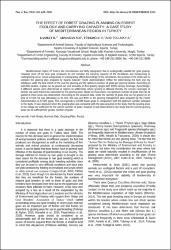THE EFFECT OF FOREST GRAZING PLANNING ON FOREST ECOLOGY AND CARRYING CAPACITY: A CASE STUDY OF MEDITERRANEAN REGION IN TURKEY
Abstract
Mediterranean region of Turkey has mountainous and hilly topography that is ecologically suitable for goat grazing. However most of the time goat producers do not consider the carrying capacity of the shrublands and overgrazing or undergrazing occur. Since overgrazing or undergrazing affect the ecology of the shrublands, the purpose of the study was to compare the grazing plan prepared by Isparta Stitytiler Forest Administration Office for determining the herb and dry substance yield, the best month of the year for grazing and the optimum number of goats per grazing hectare. According to scientific studies, 4 goats can be grazed per year annually on free grazing ranges with 100% canopy coverage. Accordingly, 3 different parcels were determined at regions in settlements where grazing is allowed thereby the canopy coverages of kermes oak were tried to be calculated for the grazing areas. Based on these ratios, the optimum number of goats that can be grazed at these areas was determined. According to the acquired data, while the number of goats that can be grazed on an area of 57.605 ha was calculated as 81.453, this was put forth in the grazing management plan prepared by the Forest Administration as 57.605 goats. This corresponds to 23,848 fewer goats in comparison with the optimum number indicated in the study. It was observed when the grazing plan was compared with the data acquired in the study that the grazing areas in the village are sufficient for the current number of goats, however it was determined in our study that the current grazing areas can be sufficient for greater number of goats.


















